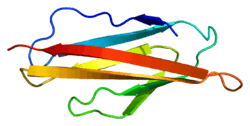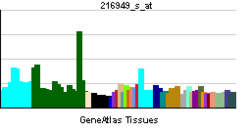Polycystin 1
| View/Edit Human | View/Edit Mouse |
Polycystin-1 is a protein that in humans is encoded by the PKD1 gene.[3][4]
Gene
Splice variants encoding different isoforms have been noted for PKD1. The gene is closely linked to six pseudogenes in a known duplicated region on chromosome 16p.[5]

Function
Polycystin-1 is a glycoprotein which contains a large N-terminal extracellular region, multiple transmembrane domains and a cytoplasmic C-tail. It may function as an integral membrane protein involved in cell-cell/matrix interactions, and may modulate intracellular calcium homoeostasis and other signal-transduction pathways. It plays a role in renal tubular development, and mutations in this gene have been associated with autosomal dominant polycystic kidney disease.
Interactions
Polycystin-1 has been shown to interact with polycystin-2[6][7] and RGS7.[8]
See also
References
- ↑ "Human PubMed Reference:".
- ↑ "Mouse PubMed Reference:".
- ↑ Hughes J, Ward CJ, Peral B, Aspinwall R, Clark K, San Millán JL, Gamble V, Harris PC (June 1995). "The polycystic kidney disease 1 (PKD1) gene encodes a novel protein with multiple cell recognition domains". Nat. Genet. 10 (2): 151–160. doi:10.1038/ng0695-151. PMID 7663510.
- ↑ "Polycystic kidney disease: the complete structure of the PKD1 gene and its protein. The International Polycystic Kidney Disease Consortium". Cell. 81 (2): 289–98. April 1995. doi:10.1016/0092-8674(95)90339-9. PMID 7736581.
- ↑ "Entrez Gene: PKD1 polycystic kidney disease 1 (autosomal dominant)".
- ↑ Tsiokas L, Kim E, Arnould T, Sukhatme VP, Walz G (June 1997). "Homo- and heterodimeric interactions between the gene products of PKD1 and PKD2". Proc. Natl. Acad. Sci. U.S.A. 94 (13): 6965–6970. doi:10.1073/pnas.94.13.6965. PMC 21268
 . PMID 9192675.
. PMID 9192675. - ↑ Tsiokas L, Arnould T, Zhu C, Kim E, Walz G, Sukhatme VP (March 1999). "Specific association of the gene product of PKD2 with the TRPC1 channel". Proc. Natl. Acad. Sci. U.S.A. 96 (7): 3934–3939. doi:10.1073/pnas.96.7.3934. PMC 22398
 . PMID 10097141.
. PMID 10097141. - ↑ Kim E, Arnould T, Sellin L, Benzing T, Comella N, Kocher O, Tsiokas L, Sukhatme VP, Walz G (May 1999). "Interaction between RGS7 and polycystin". Proc. Natl. Acad. Sci. U.S.A. 96 (11): 6371–6376. doi:10.1073/pnas.96.11.6371. PMC 26888
 . PMID 10339594.
. PMID 10339594.
Further reading
- Islam, Md. Shahidul (January 2011). Transient Receptor Potential Channels. Advances in Experimental Medicine and Biology. 704. Berlin: Springer. p. 700. ISBN 978-94-007-0264-6.
- Wilson PD (2001). "Polycystin: new aspects of structure, function, and regulation". J. Am. Soc. Nephrol. 12 (4): 834–45. PMID 11274246.
- Boletta A, Germino GG (2004). "Role of polycystins in renal tubulogenesis". Trends Cell Biol. 13 (9): 484–492. doi:10.1016/S0962-8924(03)00169-7. PMID 12946628.
- Everson GT, Taylor MR, Doctor RB (2004). "Polycystic disease of the liver". Hepatology. 40 (4): 774–782. doi:10.1002/hep.20431. PMID 15382167.
- Weimbs T (2007). "Regulation of mTOR by polycystin-1: is polycystic kidney disease a case of futile repair?". Cell Cycle. 5 (21): 2425–2429. doi:10.4161/cc.5.21.3408. PMID 17102641.
External links
This article incorporates text from the United States National Library of Medicine, which is in the public domain.




